the way of 3d drawing using 30 and 45 angles
3 Visualization
Visualization
- PERSPECTIVE
- OBLIQUE DRAWING
- ISOMETRIC DRAWING
- One-VIEW DRAWING
- TWO-VIEW Cartoon
- ORTHOGRAPHIC PROJECTION
- HIDDEN SURFACES
- CURVED SURFACES
- INCLINED SURFACES
Now that you take learned near the kinds of lines plant on prints, the adjacent step is to develop your visualization abilities. The ability to "see" technical drawings; that is to "think in iii dimensions," is the most important part of this class. Since most engineering and architectural prints utilize some form of orthographic projection (multi-view drawing), that type of drawing will exist emphasized.
Before going into a report of orthographic projection, you should be able to recognize several other types of drawings. They are; 1. Perspective cartoon, 2. Oblique drawing, and iii. Isometric cartoon. Every bit a group, they are called "pictorial drawings". They are found on prints and are piece of cake to visualize, so allow's await at their differences.
Perspective
Perspective is the most realistic course of drawing. Artists use one-point perspective, two-point (shown here), and three point to create visual depth. Perspectives are used past architects and for industrial pictorials of plan layouts, machinery, and other subjects where realism is required. Objects fatigued in perspective grow smaller as they recede into the horizon.

Oblique
Oblique drawings are drawn with i airplane (front) of the object parallel to the drawing surface. The side, or other visible part of the object is by and large drawn at 30◦ or 45◦. Annotation that simply the side is on an angle. Many times these types of cartoon are not drawn to calibration. The receding lines are drawn at 45◦ or xxx◦ and volition exist drawn at a unlike scale as the vertical and horizontal lines. This make the drawing seem "out of shape". This type of cartoon is not used very ofttimes in industry.
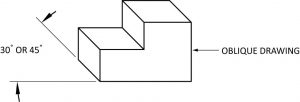
Isometric
Isometric drawings have less baloney than oblique drawings, and are used more than frequently by industry for that reason. An isometric drawing has both visible surfaces drawn at 30◦. These are the most used type of drawings in the piping manufacture and have a adept deal of do to fully understand how to depict. They best represent what is existence built and what it volition look like from the unlike sides with one drawing.
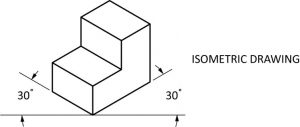
Directions: Name the types of drawings shown below. Check your own answers.
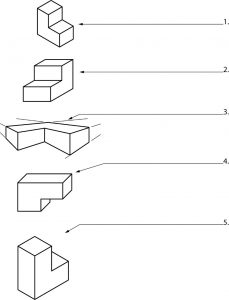
Single View
A unmarried view of an object is sometimes all that is needed for a complete visual caption. When dimensions, material, and other information is Included, an object requiring merely a single view is like shooting fish in a barrel to understand.
Most ane-view drawings are of apartment objects, made from materials such as sheet metal and gasket stock. Spherical objects, such equally a cannonball, would require merely one view and a note indicating the material and diameter of the sphere.
The object shown in the 1-view drawing beneath could be made of whatsoever appropriate material that might be specified. In appearance, it is much like the gasket used as part of the cooling organization on many cars. All that would need to be noted is the material type and thickness required.

Two View
Sometimes "two-view" drawings are use on prints. Two views may be all that is needed to show the shape of an object. Objects that are cylindrical, such equally a length of pipe, are commonly shown on a impress with ii views. In such a case, two views is sufficient to explain the shape. Notice in the 2-view cartoon shown below that the length of the piping is shown in 1 view, while the diameter is called out in the other. Without the view on the right, what might this shape be mistaken for? Foursquare tube, channel…
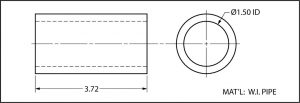
Orthographic Projection
Orthographic project is a name given to drawings that unremarkably have three views. Ofttimes, the three views selected are the top, front, and right side. Information technology is possible, of course, to select other views such as the left side or bottom. Generally, though, it's the top, front and right side that are traditionally seen by the person reading prints.
Since almost prints make use of the orthographic projection system, and because the top, front, right side views are most often used, it is of import that you accept their order, or system on the print stock-still in your heed. To assist you sympathize this system, call up of a chalkboard eraser, a short length of 2″ x 4″ lumber, or a mutual brick. Information technology looks similar this:
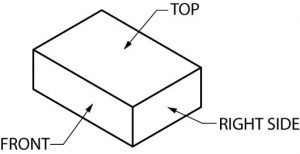
When seen on a print, using orthographic project, it would appear like this.
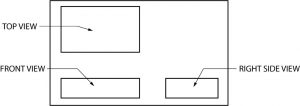
This organisation of orthographic projection may be difficult to empathise or visualize at first, but yous will grasp it with some do. Here's a basic case of how it works, using a unproblematic object.
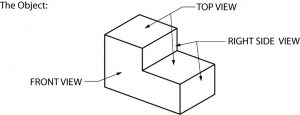
Orthographic projection does not show depth, then the object shown above will appear flat. With do, however, yous will learn to scan the three views and "read" depth into them. Call up that the location of the top, front and right side views does non alter. The projection lines between the orthographic views below show the tiptop, width, and depth human relationship that exists between each view and the other two views.
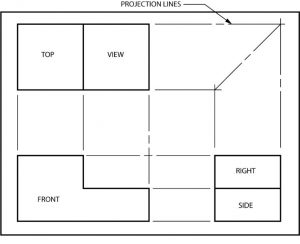
In case you did not understand the iii-view on the last page, permit's take another wait at the same thing. This fourth dimension numbers will be used for identification for the surfaces.
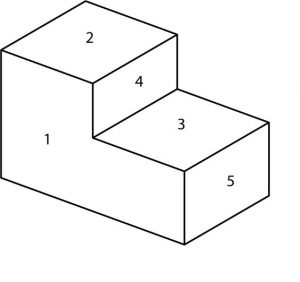
Using orthographic projection, the object with the surfaces numbered appears similar this:
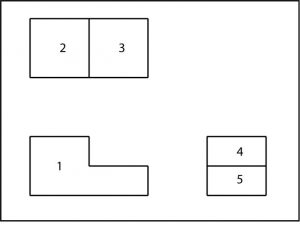
Discover that the front end view (i) is the key to the drawing, because it almost clearly shows the shape of the object. It tells you the object is "L" shaped from the forepart. The other 2 views don't tell yous much past themselves. Past looking at surface one, however, you tin run across that 2 is taller than 3. Therefore, in "reading" the surfaces, two should appear to exist closer to you than 3. Now await at four and 5. Which surface is projected closest to you?·
Reply: Surface v (rotate and place at bottom of layout)
Now draw a simple box and tape all sides together to class a cube. The cube will exist 2"x two"x ii". Once the instructor has approved your drawing you will proceed to cutting out and tape edges together to form a cube.
Visualization Quiz
Directions:
All visible surfaces on the objects shown are numbered. To complete this quiz, you are to place those numbers on the corresponding surfaces of the orthographic drawings.
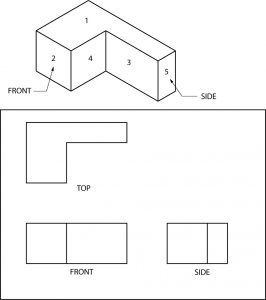
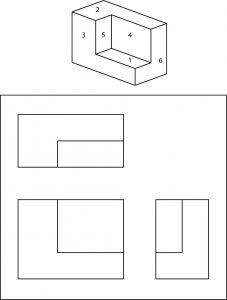
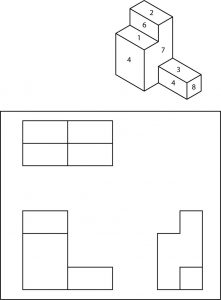
You may exist wondering at this point why something similar orthographic projection is used on prints when isometric or oblique drawings are then much easier to visualize. The answer is that both of those types of pictorials are used for relatively unproblematic drawings. When an object is complex, however, neither can equal the orthographic organisation for clear presentation of dimensions, notes, and configuration details.
Hidden Surfaces
Another reward of orthographic projection is that it allows the person reading the print to have the power to see the inside, or surfaces of an object which normally could not exist seen.
With complicated objects this can become very useful.
In the drawing beneath, the hidden line in the right side view represents the entire surface of the flat expanse between the two higher sides.
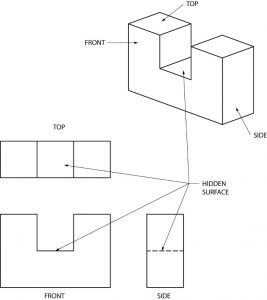
In this example, the hidden lines result from a square hole through the middle of the object.
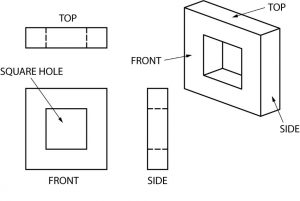
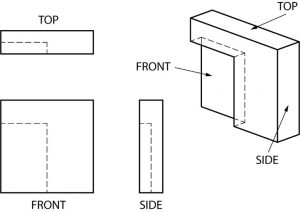
The subconscious lines in this example are there because a part of one corner of the front surface was cut away, or "recessed.
Hidden Surfaces
Directions: Draw the subconscious lines which are missing in the views beneath. Each problem has one incomplete view.
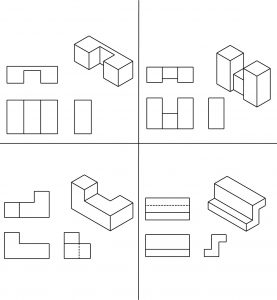
Curved Surfaces
Curved surfaces are perhaps tricky to "see" until you call back that the curve is only shown in i view. You lot must put the bend in the other views yourself, through visualization. Try to think that when there is a sharp change of direction like at a corner, then that will produce a line visible in some other view. When the change of direction is smooth like a curve, no line will be seen.
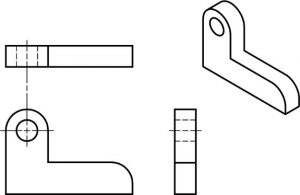
Here's another case of curved surfaces:
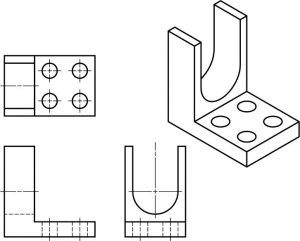
Curved surfaces exercise.
Directions: Describe the lines which are missing in the views below. Each problem has one incomplete view. Do non draw centre lines.
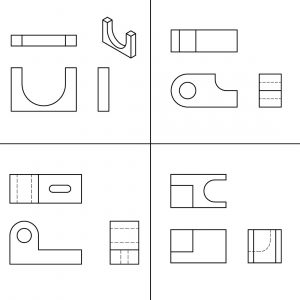
Inclined Surfaces
Inclined surfaces are those which are at an angle, or slanted. In other words, they are surfaces which are neither horizontal nor vertical. In viewing orthographic drawings you lot need to exist alarm to angles and inclined surfaces, for they are often found on the prints you volition be reading later on.
Find the hidden line in the correct view created by the inclined surface on this object:
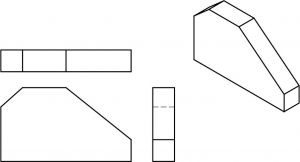
Here is an object with 2 inclined surfaces.
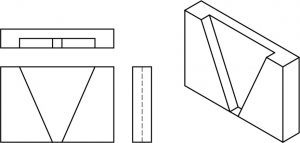
Inclined surfaces practice
Directions: Draw the lines which are missing in the views beneath. Each problem has one incomplete view.
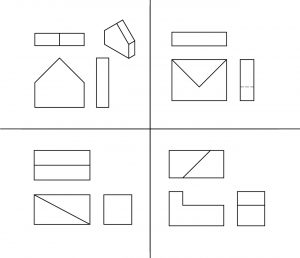
Source: https://openoregon.pressbooks.pub/blueprint/chapter/unit-2-visualization/
0 Response to "the way of 3d drawing using 30 and 45 angles"
Post a Comment